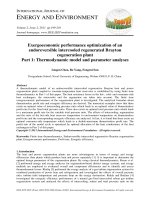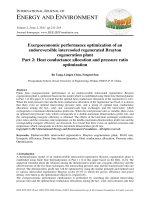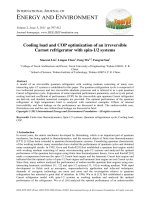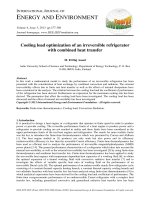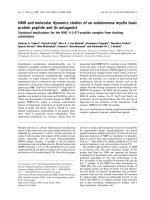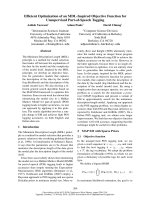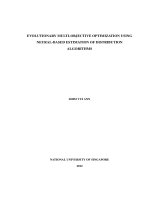SIMULATION AND MULTI OBJECTIVE OPTIMIZATION OF COLD END SEPARATION PROCESS OF AN ETHYLENE PLANT
Bạn đang xem bản rút gọn của tài liệu. Xem và tải ngay bản đầy đủ của tài liệu tại đây (2.96 MB, 133 trang )
SIMULATION AND MULTI-OBJECTIVE
OPTIMIZATION OF COLD-END SEPARATION
PROCESS OF AN ETHYLENE PLANT
SHRUTI PANDEY
NATIONAL UNIVERSITY OF SINGAPORE
2013
SIMULATION AND MULTI-OBJECTIVE OPTIMIZATION OF
SHRUTI
COLD-END SEPARATION PROCESS OF AN ETHYLENE PLANT
PANDEY
2013
SIMULATION AND MULTI-OBJECTIVE
OPTIMIZATION OF COLD-END SEPARATION
PROCESS OF AN ETHYLENE PLANT
SHRUTI PANDEY
(B.Tech. NIT Jaipur, India)
A THESIS SUBMITTED
FOR THE DEGREE OF MASTER OF
ENGINEERING
DEPARTMENT OF CHEMICAL AND
BIOMOLECULAR ENGINEERING
NATIONAL UNIVERSITY OF SINGAPORE
2013
ii
DECLARATION
I hereby declare that this thesis is my original work and it has been written by
me in its entirety. I have duly acknowledged all the sources of information
which have been used in the thesis.
This thesis has also not been submitted for any degree in any university
previously.
Shruti Pandey
10-January-2014
iii
(This page is left blank intentionally)
iv
Acknowledgements
Acknowledgements
It has been an honor to be a part of pCOM group, led by Professor G. P.
Rangaiah. He has been extremely supportive and patient throughout the two
years of my tenure at National University of Singapore. As a research
graduate, my experience in the Master of Engineering programme has been a
steep learning curve under his guidance. I have been given a disciplined and
organized training during my research-work. He ensured weekly interaction
and reasonable target-setting which gave way to a smoother transition into an
efficient researcher. He also taught me the art of scientific arguments with
genuine source of referencing which was very important to establish the
credibility of my work. I have gradually improved my writing skills, thanks to
his suggestions over my articles. Last but not the least, one quality that I have
developed from his subset of professional ethics and vow to maintain for life
is punctuality.
It was all the more a great pleasure to learn from my coursework modules by
Prof. Karimi, A/Prof. Laksh, A/Prof. Mark Saeys, A/Prof. Saif A. Khan,
A/Prof. Rajagopalan Srinivasan, and A/Prof. D. Y. Lee. I would like to
acknowledge the NUS administration, including ChBE Department staff and
Registrar’s office for functioning in one of the quickest and most efficient
manner. It was a delight to experience faster processing of applications and
smarter access to information through NUS website, Library, and many other
facilities. Latest infrastructure and innovative events around the campus had a
very positive impact on me and it gave me enthusiasm to work hard as well as
smart.
I was a part of lot of extra-curricular activities like Senior Director for Public
Relations at Graduate Students’ Society (GSS), Student Assistant at Students’
Service Centre (SSC), Technical Writer at Office of Estate and Development
(NUS), MarketZoom team with students from NUS Business and Laboratory
Assistant for module CN3421E. The experience of meeting people from
different parts of the world has widened my horizon about life. I wish to thank
all my friends, whom I met through these activities and will surely miss them.
v
Acknowledgements
I would like to give a special mention to Miss Tan Phaik Lee from SSC who
has been such a motivation during my part-time employment at SSC.
My daily life in lab E5-B-02 and around the department would not have been
so much fun and happening without the great people here. I would start by
thanking Dr. Shivom Sharma who has always been there to take me out of any
technical glitch in my work and has been really kind and helpful. Vaibhav and
Naviyn have been the best lab-mates one could ever have with their great
sense of humor and readiness to help. Wendou enlightened us a lot about life
in China and made it so much more familiar to us. Krishna has been a great
source of motivation for me as he would always encourage going deeper into
the concepts and understanding the basics well. Bhargav, Arghya, Sumit,
KMG, Ashwini, Maninder, Ammu, Hari, and Manoj have been nice (read:
mischievous) colleagues. Xu Chen was kind enough to translate a paper from
Chinese journal into English for me. Sadegh and Naresh also helped me
through optimization related issues. Rajnish and Akshay, my seniors from
undergraduate and Bharat lived up to my expectation for being the dearest
friends at NUS.
I would like to thank my Mom, Dad, my sister Avantika, my fiancée Sulabh
and his family, and all my relatives and friends in India for understanding my
busy schedule and still continuing to shower their love and care. Last but not
the least; I would like to thank God, as I thank Him every day, for being my
back in all the tough times and making me a stronger human being, with every
passing day.
vi
Table of Contents
Table of Contents
SUMMARY ...................................................................................................... ix
LIST OF TABLES ............................................................................................. x
LIST OF FIGURES .......................................................................................... xi
LIST OF SYMBOLS ..................................................................................... xiii
ABBREVIATIONS ......................................................................................... xv
Chapter 1 INTRODUCTION ............................................................................. 1
1.1
Overview ............................................................................................. 1
1.2
Industrial trends ................................................................................... 2
1.3
Olefin/Paraffin Separation................................................................... 4
1.4
Operation Optimization ....................................................................... 4
1.5
Process Retrofitting ............................................................................. 5
1.6
Motivation and Scope of Work ........................................................... 6
1.7
Outline of the Thesis ........................................................................... 7
Chapter 2 LITERATURE REVIEW .................................................................. 8
2.1
Cold-End Separation of Ethylene Process .......................................... 8
2.1.1
Process Description ...................................................................... 8
2.1.2
Analysis and Optimization ......................................................... 11
2.1.3
New Developments and Retrofitting ......................................... 18
2.2
Membranes for Olefin/Paraffin Separation ....................................... 21
2.2.1
Current Membrane Technologies .............................................. 22
2.2.2
Membrane Characteristics and Parameters ................................ 26
2.2.3
Membrane Separation Improvement Techniques ...................... 29
2.2.4
Membrane Modeling .................................................................. 30
2.2.5
Hybrid Membrane-Distillation Systems .................................... 31
2.3
Conclusions ....................................................................................... 36
Chapter 3 MULTI-OBJECTIVE OPTIMIZATION OF A CONVENTIONAL
COLD-END SEPARATION IN AN ETHYLENE PLANT ........................... 39
3.1
Introduction ....................................................................................... 39
3.2
Process Description ........................................................................... 42
3.3
Simulation of the Cold-End Separation Process ............................... 45
3.3.1
Property Package Selection........................................................ 45
3.3.2
Details of the Process and Simulation ....................................... 46
vii
Table of Contents
3.3.3
Validation of the Simulation ...................................................... 48
3.4
Formulation of Multi-objective Optimization Problems ................... 51
3.5
Results and Discussion ...................................................................... 56
3.5.1
Case 1: Maximization of Ethylene Production and Minimization
of Net Utility Cost .................................................................................... 56
3.5.2
Case 2: Maximization of Propylene Production and
Minimization of Net Utility Cost.............................................................. 59
3.5.3
Case 3: Maximization of Utility Credit and Minimization of
Total Utility Cost ...................................................................................... 62
3.6
Conclusions ....................................................................................... 65
Chapter 4 RETROFITTING SELECT DISTILLATION COLUMNS IN
COLD-END SEPARATION WITH A MEMBRANE UNIT ......................... 67
4.1
Introduction ....................................................................................... 67
4.2
Retrofitting Conventional Distillation with a Membrane Unit ......... 70
4.2.1
HMD Modeling and Simulation ................................................ 70
4.2.2
Techno-Economic Feasibility of Retrofit Operation ................. 71
4.2.3
Assumptions for Membrane Simulation .................................... 76
4.3
Formulation of Multi-Objective Optimization .................................. 77
4.4
Results and Discussion ...................................................................... 80
4.4.1
Case 1: HMD System for Deethanizer....................................... 80
4.4.2
Case 2: HMD System for Depropanizer .................................... 81
4.4.3
Case 3: HMD System for Ethylene Fractionator ....................... 83
4.4.4
Case 4: HMD System for Propylene Fractionator ..................... 85
4.5
Conclusions ....................................................................................... 87
Chapter 5 CONCLUSIONS AND RECOMMENDATIONS.......................... 88
5.1
Conclusions of this Study.................................................................. 88
5.2
Recommendations for Future Work .................................................. 89
REFERENCES ................................................................................................ 91
Appendix A: Validation of Thermodynamic Models and Flash Calculations
........................................................................................................................ 106
Appendix B: Theory of Membrane Separations ............................................ 111
Appendix C: Costing of HMD System .......................................................... 114
viii
Summary
SUMMARY
Ethylene is the largest volume petrochemical produced in the world. It is an
important building block for many chemicals like polyethylene, ethylene
dichloride, ethylene oxide and ethyl benzene. Capacity of ethylene production
worldwide touched 155.9 million tons per annum (MTA) in 2012 and it is
likely to increase [1]. It is generally produced from ethane, propane and
naphtha by thermal cracking. Ethylene separation from cracking products is
one of the most energy-intensive processes and involves separation of close
boiling-point hydrocarbons like ethylene/ethane and propylene/propane using
expensive cryogenic distillation. Hence, it is imperative to employ available
techniques for the reduction of energy consumption in ethylene plants. This
can be done by either optimizing the plant operating conditions or retrofitting
to economical separation systems like hybrid membrane-distillation system.
The primary objective of this study is to perform operation optimization of
cold-end separation process of a conventional ethylene plant. The process
simulated in Aspen Hysys and validated with typical design data. Then, using
this simulation model, multi-objective optimization (MOO) of the cold-end
separation is studied using the elitist non-dominated sorting genetic algorithm.
The major objectives were: minimizing utility cost, maximizing utility credit,
and maximizing production rate of ethylene (or propylene). It is shown that
the plant can be operated at different optimal conditions, each of which
involves some trade-off among the objectives of interest.
In the second part of this study, the techno-economic viability of retrofitting a
membrane to the existing cold-end separation process of an ethylene is carried
out. Optimization of four distillation columns, namely, deethanizer,
depropanizer, ethylene and propylene fractionator with membrane separation
was carried out for two objectives: minimizing capital cost of membrane
separation and maximizing utility cost savings for the hybrid system. It is
concluded that the hybrid systems significantly reduce the utility cost of
depropanizer, and propylene fractionator and comparatively less reduction is
observed for deethanizer. Ethylene fractionator, which generates energy credit
from the reboiler duty, is not suitable for membrane retrofitting.
ix
List of Tables
LIST OF TABLES
Table 2.1: List of Industrial Patents ................................................................. 19
Table 3.1: Feed Composition for the Cold-End Separation Process ............... 47
Table 3.2: Key Components and Overall Efficiency for Columns in the ColdEnd Separation Process shown in Figure 1 ...................................................... 48
Table 3.3: Comparison of Predicted Flow Rates with the Typical Design Data
.......................................................................................................................... 50
Table 3.4: Comparison of Predicted Temperatures with the Typical Design
Data .................................................................................................................. 51
Table 3.5: Utility Data and Prices used in the study ........................................ 53
Table 3.6: Decision Variables for Multi-Objective Optimization of Cold-End
Separation ........................................................................................................ 55
Table 3.7: Specifications of Main Products ..................................................... 55
Table 4.1: Preliminary techno-economic evaluation of HMD systems for four
columns ............................................................................................................ 72
Table 4.2: Feed and product specifications for various columns..................... 73
Table 4.3: Values of slope and front-factor of the upper-bound for
olefin/paraffin membrane separation ............................................................... 77
Table 4.4: Decision variables for MOO of various distillation columns ......... 79
Table A.1: Comparison of Adjusted R2 for Predicted Data with Experimental
Data ................................................................................................................ 110
Table C.1: Calculation Parameters for Compressor and Drives .................... 115
x
List of Figures
LIST OF FIGURES
Figure 3.1: Process flow diagram of conventional cold-end separation of an
ethylene plant ................................................................................................... 43
Figure 3.2: Pareto-optimal front for maximization of ethylene production and
minimization of net utility cost (plot a); optimal values of decision variables
corresponding to the Pareto-optimal front are shown in plots b to j. ............... 58
Figure 3.3: Pareto-optimal front for maximization of ethylene production and
minimization of net utility cost with only DM reflux ratio as the decision
variable and comparison of Pareto fronts obtained in the two runs are shown in
plot a; optimal values of DM Reflux Ratio corresponding to the Paretooptimal front for 1st and 2nd run are in plot b. ................................................ 59
Figure 3.4: Optimal Pareto front for maximization of propylene production
and minimization of net utility cost, at an interval of 50 generations (plot a);
optimal values of decision variables corresponding to the Pareto-optimal front
are shown in plots b to i. .................................................................................. 61
Figure 3.5: Optimal Pareto front for maximization of propylene production
and minimization of net utility cost with reflux rates/ratios of DE, SD, DP and
DB as decision variables (plot a); optimal values of decision variables
corresponding to the Pareto-optimal front are shown in plots b to e. .............. 62
Figure 3.6: Optimal Pareto front for maximization of utility credit and
minimization of total utility cost, at an interval of 50 generations (plot a);
optimal values of decision variables corresponding to the Pareto-optimal front
are shown in plots b to j. .................................................................................. 64
Figure 3.7: Optimal Pareto front for maximization of utility credit and
minimization of total utility cost, at an interval of 50 generations, with only
DM vent rate and DP reflux ratio as decision variables (plot a); optimal values
of decision variables corresponding to the Pareto-optimal front from 1st and
2nd run are shown in plots b to c. .................................................................... 65
Figure 4.1: Process Flow Diagram of a HMD System: Parallel Arrangement 70
Figure 4.2: Non-dominated solutions for maximization of utility cost savings
and minimization of capital cost for retrofitting DE to a HMD system (plot a);
corresponding optimal values of decision variables are shown in plots b to d.
.......................................................................................................................... 81
Figure 4.3: Optimal Pareto front for maximization of utility cost savings and
minimization of capital cost for retrofitting DP to a HMD system (plot a);
xi
List of Figures
optimal values of decision variables corresponding to the Pareto-optimal front
are shown in plots b to d. ................................................................................. 83
Figure 4.4: Non-dominated solutions for maximization of utility cost savings
and minimization of capital cost for retrofitting EF to a HMD system,
considering reboiler duty as utility credit (plot a); optimal values of decision
variables corresponding to the Pareto-optimal front are in plots b to d. .......... 84
Figure 4.5: Non-dominated solutions for maximization of utility cost savings
and minimization of capital cost for retrofitting EF to a HMD system,
considering reboiler duty as cost (plot a); optimal values of decision variables
corresponding to the Pareto-optimal front are in plots b to d. ......................... 85
Figure 4.6: Non-dominated solutions for maximization of utility cost savings
and minimization of capital cost for retrofitting PF to a HMD system (plot a);
optimal values of decision variables corresponding to the Pareto-optimal front
are shown in plots b to d. ................................................................................. 87
Figure A.1: Comparison of Experimental and Predicted Data for Methane (1)
– Propane (2) Mixture: (a) x-y Plot and (b) T-x Plot ..................................... 107
Figure A.2: Comparison of Experimental and Predicted Data for Ethane (1) –
Propene (2) Mixture: (a) x-y Plot and (b) P-x Plot ........................................ 107
Figure A.3: Comparison of Experimental and Predicted Data for Propene (1) –
i-Butene (2) Mixture: (a) x-y Plot and (b) P-x Plot ....................................... 107
Figure A.4: Comparison of Experimental and Predicted Data for Propane (1) –
Pentane (2) Mixture (a) x-y Plot and (b) P-x Plot.......................................... 108
Figure A.5: Comparison of Experimental and Predicted Data for Ethene (1) –
Ethane (2) Mixture: (a) x-y Plot and (b) P-x Plot .......................................... 109
Figure A.6: Comparison of Experimental and Predicted Data for Ethane (1) –
Propane (2) Mixture: (a) x-y Plot and (b) P-x Plot ........................................ 109
Figure A.7: Comparison of Experimental and Predicted Data for Propene (1) –
Propane (2) Mixture: (a) x-y Plot and (b) P-x Plot ........................................ 109
xii
List of Symbols
LIST OF SYMBOLS
Alphabetical Symbols
Am
Area per unit membrane
Ac
Heat exchanger area for cooler
atm
Atmospheric pressure
C
Total Module Cost of Equipment
DA
Diffusion coefficient
Fbm
Bare module factor
Fm
Material factor for the equipment
FP
Pressure factor for the equipment
ℓ
Thickness of the membrane
N
Total number of units
nA
Flux of component A through the membrane
P
Pressure
PA
Permeance of fast-permeating component A
PA,l
Permeability of fast-permeating component A
pF
Feed Pressure
pP
Permeate Pressure
Px1
Partial pressure of component x in feed
Px2
Partial pressure of component x in permeate
Perx
Permeability (Flux) for component x
ppm
Parts per Million
psig
Pound per square inch gauge
Qx
Permeate molar flow for component x
S
Power Input required by the Equipment
SA
Solubility coefficient
T
Temperature
xiii
List of Symbols
Tb
Boiling Temperature
Tc
Critical Temperature
U
Heat-transfer Coefficient
UC
Utility Cost
xF
Feed Mole Fraction
xR
Retentate Mole Fraction
yP
Permeate Mole Fraction
yi
Permeate Mole Fraction at the retentate end of the membrane
Greek Symbols
LK-HK
Relative volatility of light-heavy key components
αAB
Selectivity of A shown by the membrane as compared to slowpermeating component B
βAB
Front factor of the upper bound
ΔpA
Trans-membrane partial pressure of component A
λAB
Slope of the upper bound
σ
Lennard–Jones diameter
Feed liquid viscosity
xiv
Abbreviations
ABBREVIATIONS
BTU
British Thermal Units
CAPEX
Capital Cost
CEPCI
Chemical Engineering Plant Cost Index
CGCC
Column Grand Composite Curve
CMS
Carbon Molecular Sieve
CNT
Carbon Nanotubes
CTO
Coal To Olefins
DB
Debutanizer
DE
Deethanizer
DEA
Di-ethanolamine
DM
Demethanizer
DMC
Dimethyl carbonate
DP
Depropanizer
DS
Distillate Stripper
EC
Energy Credit
EF
Ethylene Fractionator
EP
Ethylene Production
FTM
Facilitated Transport Membrane
GJ
Giga Joules
HIDiC
Heat Integrated Distillation Column
HMD
Hybrid Membrane-Distillation
IC
Internal Combustion
LMTD
Log Mean Temperature Difference
LNG
Liquefied Natural Gas
LPS
Low Pressure Steam
MAPDH
Methyl Acetylene Propadiene Hydrogenation
xv
Abbreviations
MEA
Mono-ethanolamine
MILP
Mixed Integer Linear Programming
MINLP
Mixed Integer Non Linear Programming
MMM
Mixed Matrix Membrane
MMT
Million Metric Tons
MOF
Metal Organic Frameworks
MOO
Multi Objective Optimization
MTA
Million Tons per Annum
MTBE
Methyl Tert Butyl ether
MTO
Methanol To Olefins
NLP
Non Linear Programming
NS
Net Savings
NSGA
Non-dominated Sorting Genetic Algorithm
OPEX
Operating Cost
PCE
Purchased Cost of an Equipment
PF
Propylene Fractionator
PNMTC
Practical Near Minimum Thermodynamic Condition
PP
Propylene Production
PR
Peng-Robinson
PTFE
Polytetrafluoroethylene
SD
Secondary Deethanizer
SIHIDiC
Simple Ideal Heat Integrated Distillation Column
SQP
Sequential Quadratic Programming
SRK
Soave Redlich Kwong
TC
Target Component
VB
Visual Basic
VLE
Vapour-Liquid Equilibrium
xvi
Chapter 1
Introduction
Chapter 1
INTRODUCTION
1.1
Overview
Ethylene is the largest-volume organic petrochemical produced in the world.
The majority of it is used in the production of ethylene oxide, ethylene
dichloride, ethyl-benzene, linear alcohols, vinyl acetate, and a variety of
homo- and co-polymers (plastics ranging from plastic food wrap to impactabsorbing dashboards in cars). These chemicals are used to make consumer
and industrial products like plastics, textiles, coatings, packaging, rubber,
construction materials etc.
Increasing modernization and urbanization in
developing countries in Asia have created new markets for the consumption of
these products, thereby accelerating the demand for ethylene in these regions.
To meet this demand, the capacity of ethylene production worldwide touched
155.9 million tons per annum (MTA) in 2012 and it is likely to increase due to
newly-ventures shale gas production [1].
Ethylene plants are complex, large-scale, flexible factories that can process a
wide variety of hydrocarbon feed-stocks (ethane, propane, butane, naphtha,
gasoil, LPG) via a cracking process. The desired products and type of feedstock used are influenced by market demands and ethylene units integrated in
petrochemical plants. Many types of co-products can be generated with
different equipment. Main products are polymer-grade ethylene and
propylene. Ethane, ethylene, propane and propene can be obtained by
hydrogenating C2 and C3 acetylenes. Aromatics can be recovered from hydrotreated pyrolysis gasoline. Butadiene, butylenes, isobutylene or mixtures can
be obtained from C4 stream. Isoprene, piperylene and cyclopentadiene can be
obtained from C5 stream. Ethane is recycled as cracking feed-stock, or used as
a fuel. Fuel oil can be used as fuel or to produce coke and carbon black.
Hydrogen and methane can be used as fuel, or sold. Naphthalene can be
obtained for selling purposes. Propane is fed to the steam crackers, used as
fuel or sold. Propene is available in various grades like chemical grade. Raw
pyrolysis gasoline can be hydro-treated and sold as gasoline or is used in
aromatics production as feed. Tar is can be used as fuel, for road-making
1
Chapter 1
Introduction
purposes, or used as a feedstock for making coke and resins. Sulfur can be
recovered and sold [2].
1.2
Industrial trends
An environment of mixed global demand is growing for ethylene, with
markets expanding in developing regions and slowdown in developed regions.
After contraction in 2008, it was forecasted to be approximately 135 million
metric tons (MMT) in 2013, which was higher than the previous demand peak
of nearly 130 MMT in 2012. In the next five years, it is forecast to grow at
more than 4%/yr, reaching nearly 160 MMT tons by 2017 [3].
The ethylene industry witnesses a frequent rise and fall in margins, which
determine whether existing plants have to be revamped or new grass-root plant
need to be built, respectively. A number of reasons are responsible for a
revamp like health, safety and environmental requirements, expansion of
capacity and process improvements. However, ethylene process is extremely
sensitive to minor changes, and no major adjustments should be made in the
operations of the unit when the plant has reached steady state. Hence, a very
strong objective and direction is required by the process engineer before
embarking into a revamp exercise [4].
Five years ago, when the ethylene capacities were on the verge of shutdown,
US ethylene industry is now experiencing a complete turnaround. High
ethylene margins due to low regional ethane prices are generating profits for
producers, despite a global oversupply situation. The ethane-based producers
are in more profitable position than their naphtha counterparts. A report has
reasoned the low prices of ethane as a result of ample supplies of natural gas
liquids from shale development [3].
Now that US ethylene industry is nearing its maximum capacity utilization,
there is a tremendous amount of capital investment underway, including new
infrastructure needed for feedstock supply, ethylene and ethylene-derivative
capacity, and new logistics investments to support higher levels of ethylenederivative exports. This will create more supply than demand in the domestic
market, and it is expected to be diverted to Asian markets like China and
2
Chapter 1
Introduction
India, where demand is greatest and the scenario is completely favorable for
producers in Middle East, other parts of Asia and North America [3].
1) FEPCO, a subsidiary of Rosneft, is developing the Russia Far East
olefins project. Processing capacity of the petrochemical complex is
planned at 3.4 million tpy of hydrocarbon feedstock, predominantly
naphtha. The capacity of ethylene and propylene production unit is
planned at 2 million tpy. The complex is expected to be started up in
2017 [5].
2) Dow Chemical will build a world-scale ethylene plant at its chemical
hub in Freeport, Texas, to utilize cheaper feed-stocks available from
increasing US shale gas supplies. [6].
3) China is trying to capitalize on the huge domestic supply of coal by
using coal-to-olefins (CTO) processes for meeting the local demand of
several chemical feed-stocks like especially ethylene and propylene An
IHS study assessed CTO processes which include the gasification of
bituminous coal by GE Texaco or Shell gasifiers to produce synthetic
gas, followed by methanol synthesis and methanol-to-olefins (MTO)
production [7]. KBR has recently got a license to design an olefinsrecovery unit in Yulin, Shaanxi Province, China. [8].
4) SK Global is working with Sinopec for starting a petrochemical plant
in Wuhan, central China, with an annual capacity of 2.5 million tons of
petrochemicals [9].
5) ExxonMobil plant in Singapore has recently started production of
ethylene using the second steam cracker with the finest world-class
technology. [10].
These above-mentioned developments in ethylene capacity additions and
production are important because ethylene is the “bell weather” product for
assessing the health of the petrochemical industry as it is by far the largest
market of the basic petrochemical building blocks, including olefins,
aromatics, chlor-alkali and syngas chemicals [3].
3
Chapter 1
1.3
Introduction
Olefin/Paraffin Separation
Olefin/paraffin separation is often categorized as one of the difficult
separations in petrochemical industry. This is due to the small differences in
physical properties such as boiling points between olefins and paraffins with
same number of carbon atoms. Currently, highly energy intensive low
temperature (cryogenic) distillation is used for carrying out such separations at
the industrial level. These require one or two-column configurations
containing 150 – 200 trays at temperatures around 200 K and pressures around
18 bar for obtaining high product purities, necessary for further
polymerization reactions. Such low temperatures and high pressures are due to
the similar boiling points of light olefins and their corresponding paraffins.
Around 3% of total US Energy is consumed by nearly 40,000 distillation
columns in refineries and petrochemical plants, separating organic liquid
mixtures [11].
1.4
Operation Optimization
There are many challenges faced by the olefin producers due to rise in crude
oil prices as well as global warming concerns, some of which are yield
improvement, product maximization and energy intensity reduction in the
product recovery section. With advanced control and optimization technology,
annual production can be increased and energy consumption can be decreased,
resulting in substantial economic benefits in millions of dollars.
An olefin plant contains a separation train of distillation columns integrated
with compression network and refrigeration system, apart from flash drums,
heat exchangers, pumps and acetylene reactors. The olefin/paraffin separation
is associated with various operating characteristics which can be broadly
divided into two categories. The universal characteristics include 1) no
product blending, 2) stringent product quality requirements, 3) slow dynamics
from gate to gate, 4) gradual furnace and converter coking, 5) frequent furnace
decoking and switching and 6) converter decoking. The site-specifics cover 1)
feed quality variations, 2) product demand changes, 3) sensitivity to ambient
conditions and 4) periodic switching (for example, dryers). The main
operating degrees of freedom for ethylene plant-wide control and optimization
4
Chapter 1
Introduction
include feed selection, furnace feed rates, cracking severity, dilution steam,
cracked gas compressor and refrigeration compressor suction pressures,
typical column variables (reflux, reboiler, and pressure), and converter
temperature and H2 ratio. Advanced control and optimization goals include
stabilizing operation, minimizing product quality giveaway, maximizing
selectivity and
yield,
minimizing
converter
over-hydrogenation
and
minimizing ethylene loss to methane and ethane recycle [12]. With such
multi-dimensional characterization and energy-intensive nature of the process,
fine-tuning of various variables is necessary to minimize utility costs while
maximizing production rates. This makes ethylene process an ideal candidate
for steady-state multi-objective operation optimization.
1.5
Process Retrofitting
Various technologies have been developed to replace the traditional lowtemperature distillation like extractive distillation, physical adsorption using
molecular sieves, chemisorption using complexing metals like copper and
silver ions, absorption (physical and chemical), and membrane separation.
Since the last three decades, research has gathered momentum in the area of
membrane applications for olefin/paraffin separation. However, due to harsh
industrial operating conditions like high pressure and high feed flowrates,
these systems could not be scaled-up and fully replace the conventional
distillation. Nevertheless, membranes have proved to provide a cost-effective
method of separation through various experiments of gas permeation and
pervaporation for different hydrocarbon mixtures at laboratory scale. This has
gradually led to the concept of hybrid membrane-distillation systems which
aim at reducing the overall energy consumption of a distillation by virtue of
separation characteristics of the associated membrane. Although, there is an
absence of suitable membrane materials at industrial scale, certain polyimide
membranes have showed promising results towards the hydrocarbon
separation. Hence, a hybrid process combining a membrane unit and a
distillation column is of high interest for petrochemical engineers from
retrofitting point of view.
5
Chapter 1
1.6
Introduction
Motivation and Scope of Work
Being an energy-intensive process on a large-scale, cold-end separation of an
ethylene process is a matter of great interest, particularly from the multiobjective optimization perspective. The resulting Pareto fronts can be useful
for selecting the right operating conditions for the process, depending upon the
preferences of the user. A small percentage reduction in energy consumption
can lead to savings in thousands of dollars annually. Moreover, advanced,
energy efficient technologies like hybrid-membrane distillation systems must
be studied for their commercial demonstration and economic feasibility. Most
of these technologies claim huge energy savings at the laboratory scale but fail
to commercialize due to several operation hazards like high feed pressure and
high feed flowrates. Hence, a techno-economic evaluation can reveal whether
retrofitting of an ethylene separation process with hybrid-membrane
distillation system in different columns is a viable option or not.
In this study, operation optimization of a conventional ethylene separation
process has been conducted with for multiple objectives simultaneously.
Retrofitting opportunities in this process are also explored using hybridmembrane distillation systems. Specific objectives of this study are:
To simulate a conventional cold-end separation of ethylene process
using Aspen Hysys and to validate it on industrial design data.
To perform multi-objective optimization of conventional cold-end
separation of ethylene process using NSGA-II.
To investigate potential of hybrid membrane-distillation system for
deethanizer, depropanizer, ethylene and propylene fractionators in
ethylene process.
To perform multi-objective optimization of retrofitted hybrid
membrane-distillation systems using NSGA-II.
To carry out techno-economic evaluation of the process of both
conventional and retrofitted processes.
6
Chapter 1
1.7
Introduction
Outline of the Thesis
Chapter 1 is the introduction to the thesis topic; it provides an overview of
ethylene industry, operation optimization and process retrofitting, motivation,
scope of work and outline of the thesis chapters.
Chapter 2 contains process description of cold-end separation of ethylene
plant, a review of literature related to ethylene process, including analysis,
optimization, and new developments and retrofitting. Second part of this
chapter covers the history of membranes in olefin/paraffin separation, effect of
various membrane parameters, techniques for improving membrane
performance and hybrid-membrane distillation systems.
Simulation and optimization of conventional cold-end separation of ethylene
process are presented in Chapter 3. It covers the step-by-step method of
process simulation using Hysys and also multi-objective optimization using
NSGA-II. Results of Pareto fronts obtained for various set of objectives are
presented and discussed in the later part of Chapter 3.
In Chapter 4, retrofitting of conventional process with hybrid-membrane
distillation systems is discussed; it includes discussion on recent hybrid
membrane-distillation applications, techno-economic evaluation of the
retrofitted systems and assumptions related to membrane simulation. Multiobjective optimization of hybrid-membrane distillation systems is also
discussed.
Conclusions from the study and recommendations for further work are given
in Chapter 5.
7
